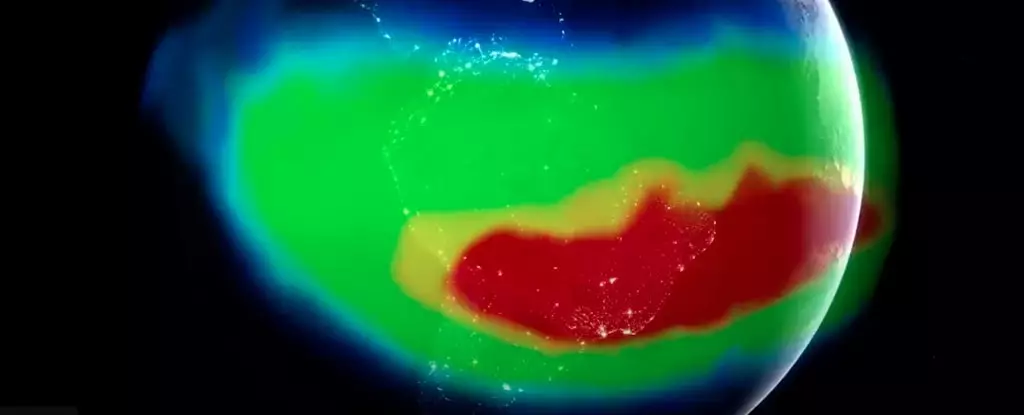For decades, the South Atlantic Anomaly (SAA) has presented a perplexing challenge to scientists and space agencies worldwide. Often described as a “dent” or “pothole” in Earth’s magnetic shield, this sizable region exhibits a markedly weakened magnetic field intensity. While this phenomenon largely remains invisible to those on Earth’s surface, its effects reach into the realm of space, where highly sensitive satellites and spacecraft operate in close proximity to the anomaly. It is an intriguing and somewhat unsettling insight into the complex magnetic dance happening beneath our feet—an invisible force that influences not just our planet’s protection but also the safety and functionality of our technological infrastructure in space.
The SAA’s presence cannot be understated: it is a persistent magnetic irregularity that appears to be slowly shifting and evolving over time. Its location stretches over the South Atlantic, encompassing parts of South America and southwestern Africa. This vast region acts as a weak link in Earth’s magnetic armor, exposing orbiting hardware to increased levels of charged solar particles that can cause malfunctions, data corruption, or even catastrophic damage. While the general public might not experience direct consequences, the ripple effects resonate through satellite communications, GPS systems, weather monitoring, and national security assets—highlighting the critical importance of understanding this magnetic anomaly.
Deciphering the Core of the Anomaly
The origins of the South Atlantic Anomaly lie deep within Earth’s interior, rooted in the tumultuous behavior of the planet’s molten outer core. Earth’s magnetic field is generated by the dynamo action of liquid iron flowing within this iron-rich outer core, creating electrical currents that produce magnetic lines of force. However, the process is anything but uniform. Variations in flow and composition can produce localized irregularities, and the SAA appears to be one such manifestation—all stemming from complex interactions within Earth’s deep, opaque layers.
Researchers attribute the weakening of the magnetic field in this region to the influence of the African Large Low Shear Velocity Province (LLSVP), an enormous mass of dense rock located thousands of kilometers beneath the African continent. This massive geological structure disrupts the usual flow patterns of molten iron, resulting in localized magnetic anomalies—regions where the magnetic field’s intensity diminishes to a fraction of its usual strength. NASA scientists explain that this localized weakening can sometimes even feature reversed magnetic polarity, further complicating the landscape of Earth’s magnetic topology.
An intriguing aspect of the anomaly is its apparent dynamic nature. Data indicates that the SAA is not static; it drifts gradually across the Earth’s surface. Observations suggest that the anomaly might be dividing into two separate lobes or cells, each with its own center of minimal magnetic strength. These spatial changes imply an ongoing evolution of the anomaly, potentially driven by shifts in the core’s behavior or interactions with other large-scale geological features. Understanding this movement is crucial, especially as it could alter the risk profile for spacecraft traversing low-Earth orbit.
The Implications and Future Uncertainties
One of the most significant concerns surrounding the SAA is its potential impact on space-borne technology. Satellites, including aloft scientific instruments and navigation systems, routinely pass through this weakened magnetic zone. During such encounters, the reduced magnetic barrier makes components susceptible to charged particles from solar activity. This exposure can lead to system malfunctions, data loss, or even irreversible damage—particularly for spacecraft that lack robust shielding or fault-tolerant systems.
This vulnerability has compelled agencies like NASA to actively monitor and mitigate the effects of the SAA. Satellite operators often shut systems down temporarily before entering the anomaly zone to prevent damage. Yet, these preventative measures are merely reactive; they highlight our limited capacity to influence or control a natural phenomenon rooted in the deep Earth’s interior. In essence, humanity is still dancing around understanding the fundamental drivers behind this magnetic irregularity.
Scientists are increasingly recognizing that the SAA is not a recent anomaly but may be part of a recurrent cycle—possibly lasting millions of years. Evidence suggests that such magnetic dips have appeared periodically in Earth’s history, with the SAA potentially being a persistent feature that fluctuates over geological time scales. Far from being a harbinger of planetary catastrophe, the anomaly might be an inherent aspect of Earth’s magnetic dynamo, perhaps serving as a natural relief valve for the planet’s magnetic stresses.
Despite these insights, many questions remain unanswered. Will the SAA continue to split and drift? Could changes in its structure influence the onset of a magnetic pole reversal? The scientific community remains cautious, emphasizing the need for continued observation and research. As our technological reliance grows—more satellites, spacecraft, and orbital stations—the importance of understanding and predicting such magnetic phenomena increases exponentially. The SAA is a stark reminder that beneath our seemingly stable planet lies a dynamic, ever-changing core—a force both fascinating and formidable in its influence over life and technology alike.

